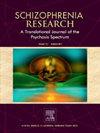精神分裂症新表型的机器学习
IF 3.5
2区 医学
Q1 PSYCHIATRY
引用次数: 0
摘要
目的:精神分裂症谱系障碍(精神分裂症)患者的异质性和并发疾病的高患病率使得确定最佳治疗方法变得困难。本研究使用机器学习识别精神分裂症成人医疗补助要求的行为健康表型。我们比较了表现型的临床结果和精神药物处方模式的临床效度。方法使用2010年1月至2012年12月的国家医疗补助申请,我们确定了249,006名18-64岁的成年人,其中住院和/或门诊索赔≥1例,主要或次要诊断为精神分裂症(icd295)。Xx)。2010年,潜在狄利克雷分配(LDA)纳入了他们的行为健康共发生障碍,以确定行为健康表型,并使用5倍交叉验证进行验证。对2011年精神药物类型的每种表型以及任何行为健康住院或急诊(ED)就诊的可能性进行两两比较。结果经5倍交叉验证的slda鉴定出5种行为健康表型,我们标记为抑郁、物质使用、躁狂混合情绪、焦虑-偏执和行为障碍-发育迟缓;第六种表型没有共同发生的疾病。行为健康住院和急诊科就诊的可能性在不同表型之间存在显著差异。精神药物处方的表型是不同的。使用与2017年383849名成年人医疗补助申请相同的方法进行的事后分析发现了可比较的表型。本研究证明了使用机器学习和索赔数据来识别精神分裂症患者行为健康表型的可行性。未来针对混杂偏倚的药物流行病学调查将比较每种表型的治疗效果,为确定精神分裂症患者的个性化治疗提供信息。本文章由计算机程序翻译,如有差异,请以英文原文为准。
Machine learning for novel phenotyping in schizophrenia
Purpose
Heterogeneity among people diagnosed with schizophrenia-spectrum disorders (schizophrenia) and high prevalence of co-occurring disorders makes identification of optimal treatments difficult. This study identified behavioral health phenotypes using machine learning with Medicaid claims of adults with schizophrenia. We compared the phenotypes' clinical outcomes and psychotropic medication prescription patterns for clinical validity.
Methods
Using national Medicaid claims from January 2010 – December 2012 we identified 249,006 adults ages 18–64, with ≥ 1 inpatient and/or ≥ 2 outpatient claims with principal or secondary diagnoses of schizophrenia (ICD9 295.xx) in 2010. Latent Dirichlet Allocation (LDA) incorporated their behavioral health co-occurring disorders in 2010 to identify behavioral health phenotypes, validated using 5-fold cross validation. Pairwise comparisons among each phenotype of psychotropic medication types, and likelihoods of any behavioral health inpatient admission or emergency department (ED) visit in 2011 were conducted.
Results
LDA with 5-fold cross validation identified 5 behavioral health phenotypes we labeled depression, substance use, mania-mixed mood, anxiety-paranoid, and conduct disorder-developmentally delayed; a sixth phenotype had no co-occurring disorders. Likelihoods of behavioral health inpatient admissions and ED visits were significantly different between the phenotypes. Psychotropic medications prescribed to the phenotypes were distinct. Post-hoc analyses using the same methods with 2017 Medicaid claims of 383,849 adults identified comparable phenotypes.
Conclusions
This study demonstrated the feasibility of using machine learning with claims data to identify behavioral health phenotypes among individuals with schizophrenia. Future pharmacoepidemiologic investigations addressing confounding bias will compare effectiveness of treatments for each phenotype, informing efforts to identify personalized treatments for people with schizophrenia.
求助全文
通过发布文献求助,成功后即可免费获取论文全文。
去求助
来源期刊

Schizophrenia Research
医学-精神病学
CiteScore
7.50
自引率
8.90%
发文量
429
审稿时长
10.2 weeks
期刊介绍:
As official journal of the Schizophrenia International Research Society (SIRS) Schizophrenia Research is THE journal of choice for international researchers and clinicians to share their work with the global schizophrenia research community. More than 6000 institutes have online or print (or both) access to this journal - the largest specialist journal in the field, with the largest readership!
Schizophrenia Research''s time to first decision is as fast as 6 weeks and its publishing speed is as fast as 4 weeks until online publication (corrected proof/Article in Press) after acceptance and 14 weeks from acceptance until publication in a printed issue.
The journal publishes novel papers that really contribute to understanding the biology and treatment of schizophrenic disorders; Schizophrenia Research brings together biological, clinical and psychological research in order to stimulate the synthesis of findings from all disciplines involved in improving patient outcomes in schizophrenia.
 求助内容:
求助内容: 应助结果提醒方式:
应助结果提醒方式:


